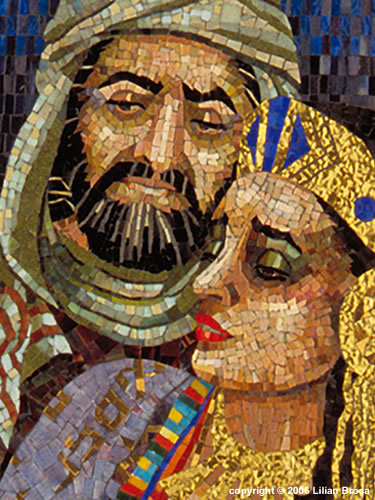 Briefly the story from the Book of Esther tells us that Jewish exiles from the Kingdom of Judah who had been living in the Babylonian captivity (6th Century BCE) found themselves under Persian rule after Babylonia was in turn conquered by the Persian Empire.
Briefly the story from the Book of Esther tells us that Jewish exiles from the Kingdom of Judah who had been living in the Babylonian captivity (6th Century BCE) found themselves under Persian rule after Babylonia was in turn conquered by the Persian Empire.According to the Book of Esther, Haman, royal vizier to King Ahasueres planned to kill the Jews, but his plans were foiled by Esther, his queen. Mordechai, a palace official and cousin and foster parent of Esther, subsequently replaced Haman. The Jews were delivered from being the victims of an evil decree against them and were instead allowed by the King to destroy their enemies, and the day after the battle was designated as a day of feasting and rejoicing.

The feast if celebrated on the 15th day of Adar and is a fun holiday especially for children who wear masks and get to make lot's of noise whenever Haman's name is mentioned.
 Incidently the word Megillah or Megila mean's Esther. This book in Hebraic tradition is from the Ketuvim or writings.
Incidently the word Megillah or Megila mean's Esther. This book in Hebraic tradition is from the Ketuvim or writings.With all that said. I came across this interesting article in the Jerusalem Post. Enjoy.
From the Jerusalem Post, March 11th, 2008
By Michael Freund
A few months ago, the normally hostile Iranian regime took the rather unusual step of adding a Jewish holy site to its National Heritage List.
On December 9th, 2008, Iranian news outlets reported that the tomb of Mordechai and Esther, the heroes of the Purim saga, would now be under official government protection and responsibility.

The move cast a brief spotlight on the site, which is well-known to Iranian Jews but largely unfamiliar to those outside the country. And with Purim being celebrated this week, it is worth taking a moment to ponder this relic of our ancient past.
The mausoleum housing the shrine of Mordechai and Esther consists of a simple brick structure crowned with a dome which was built five to seven centuries ago over the underground grave sites. It is located in the northwestern city of Hamadan, about 335 kilometers west of Teheran. According to tradition, Hamadan is believed to be the site of the city of Shushan, which played such a central role in the events described in the Book of Esther.
Various travelers down through the ages took note of the site, with the first having been Benjamin of Tudela, the famed 12th century Jewish explorer.
Iranian Jews revered the shrine, and many would travel to Hamadan to observe Purim there by reading the Megila alongside the tomb. Others held family celebrations, such as bar mitzvas or circumcisions, at the site.
The entrance to the building is said to have been built intentionally low to compel visitors to bow their heads upon entering, thereby engendering a requisite attitude of respect. Inside the main hall, which is adorned with Hebrew inscriptions, lie two large, decorated wooden boxes, or trunks, below which are said to be the final resting places of Mordechai and Esther.
A small synagogue adjoins the tomb, and the site is also considered holy by Muslims and Christians, who come to pray there.
Next to the mausoleum lies a large hollow in the ground, which Iranian Jews believe to be the entrance to a tunnel that stretches all the way to Jerusalem.
Interestingly there is a competing tradition which identifies the traditional burial place of Queen Esther and Mordechai as being on the outskirts of the village of Baram, in the Upper Galilee, near Safed.
As early as 1215, Rabbi Menahem Hahevroni wrote that while visiting the Galilee, he came across the tomb of Queen Esther, "who, during her lifetime, had instructed her son Darius to bring her there [for burial]."
Later pilgrims mentioned the site, and noted that special celebrations were held there on Shushan Purim.
Currently, the tomb is believed to be located in the ruins of a building found in the Baram National Park.
After the area was liberated in the War of Independence, a group of Safed Jews went up to the tomb on Purim in 1949 and read the Megila there to revive the long-standing custom of previous generations.
Hence, we have two conflicting traditions as to where the protagonists of the Purim story are buried, with one placing them in Persia and the other much closer to home.
And while we cannot say with any certainty which of the two traditions is more authentic or correct, of one thing we can all be sure: The deeds of these two great Jewish heroes will never fade from our collective memory.
As the Megila (9:28) tells us: "And these days of Purim shall not pass from among the Jews, and their memory shall not lapse from among their descendants."
No comments:
Post a Comment